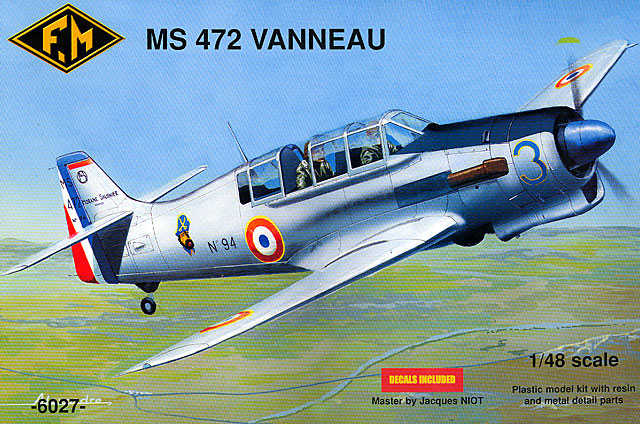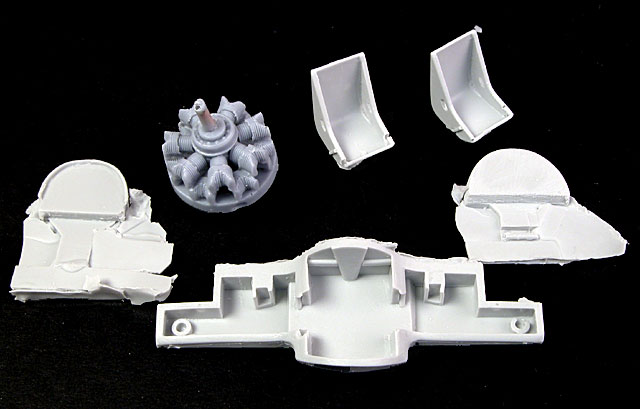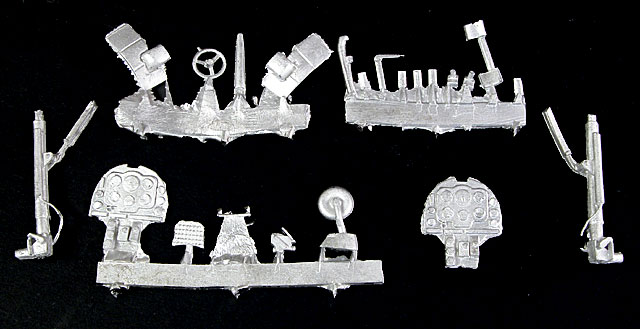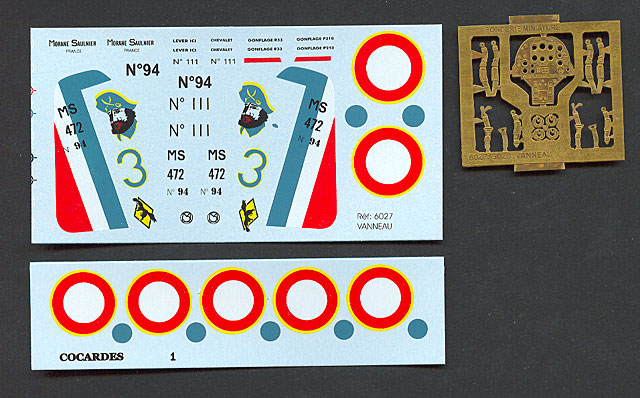|
MS.472 Vanneau II
Radial Engine
Version

Fonderie Miniatures

Fonderie
Miniatures' 1/48 scale MS.472
is available
online at Squadron.com
S
u m m a r y
|
| Catalogue Number: |
Stock No. FN6027 |
| Scale: |
1/48 scale |
| Contents and Media: |
30 limited-run injection plastic
parts; 21 white metal parts; 6 resin parts; 2 vacform; 1 fret of
photo-etched brass |
| Price: |
USD$50.97 from Squadron.com |
| Review Type: |
First Look |
| Advantages: |
Interesting subject matter;
effective and appropriate use of multi-media; good level of detail; robust
engineering; detailed white-metal landing gear; spare vacform canopy
supplied. |
| Disadvantages: |
Modelling skills required:
possible challenges fitting rear windows; lots of flash; only one
photo-etched instrument panel supplied. |
| Recommendation: |
Recommended to experienced
modellers. |
Reviewed by
Brett Green
Design work on the Vanneau family of aircraft
started as early as 1940.
The first prototype MS.470 took to the air in 1945.
Various powerplants were used with the Vanneau during its development,
including a batch of Gnome et Rhone air-cooled, double row radial engines
left behind by German forces after the occupation. The MS.472 Vanneau II
was powered by this engine.
The Vanneau II was used for training French Reserve Pilots
in France and North Africa.
Fonderie Miniature continues to work its way through
post-war French aviation, producing both familiar and lesser-known
aircraft. I confess that I was not aware of the MS.472 Vanneau before
taking delivery of the review kit, but it is an interesting
subject.
Fonderie Miniature's new 1/48 scale Vanneau II is a limited-run,
multi-media kit. The kit comprises 30 low-pressure injection moulded
parts, 6 resin parts, 21 pieces in white metal and a small photo-etched
fret. The canopy is
provided as a vacform part, and a spare is supplied. Markings for two
schemes are also included.
The bulk of the kit is styrene. The plastic parts feature
engraved detail, and the surfaces of the main parts are smoother than in
previous releases. However, there is a significant amount of ragged flash on most parts.
I estimate that it will take less than an hour to remove all the parts,
sand the surfaces and clean up the edges. This will be an hour well spent, especially
considering the natural metal finish that will follow construction.
The wing
trailing edges are quite thin, but a few seconds sanding the inside
surfaces will also be a good investment.
Engineering is sound. The wings are full-span, upper and
lower. The fuselage sits over a saddle on the upper wing half (which also
contains the cockpit floor). A ridge on each side of the lower wing root
should ensure a fairly precise fit.
The engine, seats, instrument panel mounts and main wheel well are all supplied in
grey resin. The engine is especially well-detailed. The wheel well
includes locating positions for the main gear legs and the retractions
struts - a relative luxury for a limited-run kit like this.

Two harnesses and a single instrument panel are supplied on the
photo-etched fret. It is a shame that the second instrument panel was not
also supplied, as the photo-etched version is far superior to the
white-metal alternative.
The undercarriage and a host of smaller details are supplied in white metal. This media
will ensure maximum strength for the undercarriage plus a measure of adjustment after the legs
are secured to the fuselage. The white metal parts are nicely detailed but
some parts are surrounded by thin flash -
they should look great after the customary clean-up.
The main gear legs include cast-on hydraulic lines,
although one of my lines is short-shot (won't take long to replace with
fusewire).
Those white-metal cowl flaps look like they will need a
fair amount of work to fair-in to the cowl area.

The glasshouse canopy is supplied as a vacform part. This is quite
thin, extremely clear and free of distortion. A spare is provided in case of mishaps while the canopy is
being removed from its backing.
The rear windows are supplied as separate vacuum formed
parts with recessed rims that appear to plug into rectangular openings in
the mid fuselage.

Instructions and the marking guide are supplied on two
double-sided sheets of A4 paper using exploded view drawings. The drawings
and the sequence of assembly are quite straightforward. Fonderie Miniature
has not numbered their parts but they have indicated whether the part is
resin, white metal or photo-etched.

Markings for two North African based Vanneau IIs are
supplied. The option pictured on the box top is especially colourful,
with blue spinner cap, blue and yellow digit and a pirate motif on the
fuselage side. Decals on my sample are thin and in perfect register.
Fonderie Miniature's 1/48 scale MS.472 is a nicely
detailed, soundly designed kit that should look great when finished.
However, as is the case with other Fonderie Miniature releases,
modelling skills are required - this is not a "shake and bake"
proposition. Patience, planning and plenty of test-fitting will be the best
formula for approaching this model.
The inclusion of resin, brass and metal pieces will lift
the finished product to a high standard if adequate preparation and effort
is applied.
So, if you have some experience with limited-run
multi-media kits, FM's 1/48 scale MS.472 Vanneau II should present you
with a rewarding building experience and a nice model as a result of your
time and skill.
Recommended.
Thanks to Squadron.com
for the review sample
Review and Images Copyright © 2003 by Brett
Green
Page Created 16 June, 2003
Last updated 12 August, 2004
Back to HyperScale Main Page
Back to Reviews Page
|
Home | What's
New | Features
| Gallery |
Reviews | Reference
| Forum
| Search